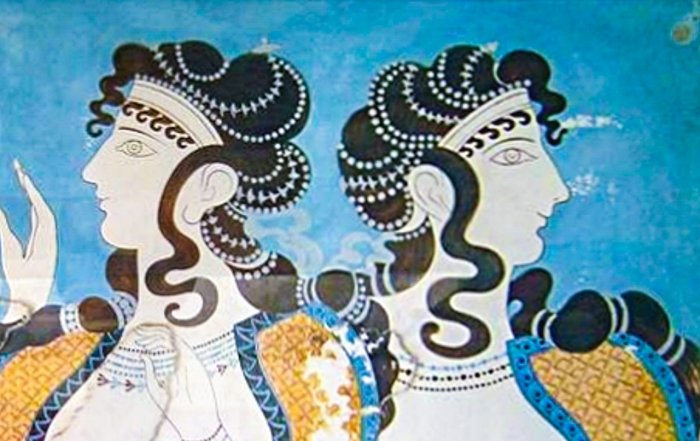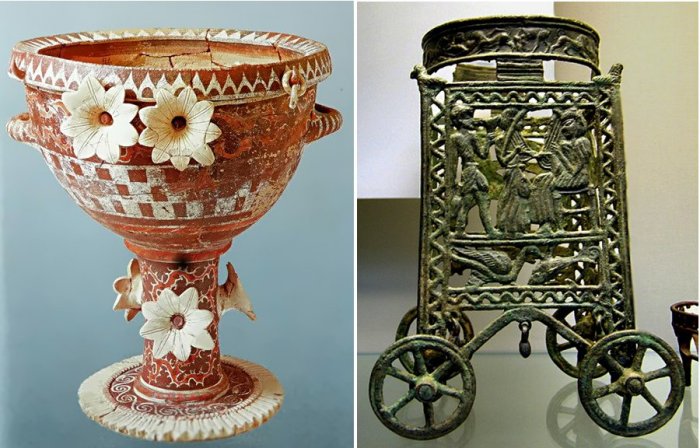Minoans: Highly Advanced Bronze Age Civilization Of Europe
A. Sutherland - AncientPages.com - Minoan society developed at the end of the third millennium BC on the largest island of the Aegean Sea – Crete, which was ruled by the legendary king Minos, a son of Zeus and Europa. They also inhabited many other small islands within the Aegean Sea.
A depiction of elite Minoan women. A fresco from the palace of Knossos, made 1500 BCE. Image source - CC BY-SA 2.0
A long time ago, Crete played a very important role in Europe with its crucial strategic location in the East Mediterranean Basin. The island was the cradle of the Minoan civilization and the bridge between the peoples and cultures of three continents: Europe, Africa, and Asia.
After the four and half millennia of Neolithic culture, the Minoan's flourishing period lasted from about 3000 to close to 1000 BC (or from approximately the 27th century BC to the 15th century.) Generally, we can say that the Minoans would have, therefore, lived almost 5,000 years ago.
They represented one of the oldest cultures of the Bronze Age in the Mediterranean area and the first major Aegean civilization comparable in its achievements to the older ones, such as Egypt, Mesopotamia, and Anatolia.
From the name of the ruler comes the term of the whole culture, which was called ‘Minoan’ by a British archaeologist, Sir Arthur Evans (1851- 1941), who brought to light an unknown civilization that confirmed the ancient accounts of Cretan society.
Minoan fresco of the town of Akrotiri, Santorini, Greece - ~ 1600 B.C. Image source - Public Domain
In the early 20th century, Evans and his team unearthed the remains of the massive palace complex at Knossos, one of the most famous archaeological excavation sites in history. Myths preserved by ancient writers say that Knossos was the seat of the King Minos.
Probably, the first settlers arrived about 7000 BC from Asia Minor. However, the origin of the Minoans is still a puzzle, and so is their original name, but the Egyptians called them "Kefti"; today, they are called Minoans.
As Gerald Cadogan, Prof. of Classical Archaeology at the University of Cincinnati, wrote:
“If we know little about how the Neolithic peoples arrived in Crete, we know equally little about how they left or came to an end, and were then succeeded by the Minoans. Perhaps there was a gap in Crete’s history and the Minoans arrived at deserted sites? Or Neolithic survivors may have mixed with Minoan immigrants? Or perhaps there were no Minoan immigrants at all, but rather the Early Minoan culture grew out of the Neolithic in a way that is not yet clear? 1
Left: Kamares crater banquet vessel with decorative lillies. Phaistos. Old-Palace period (1800-1700 BC); Right: Minoan bronze stand, c.1400BC Cyprus, exhibited at The British Museum.
The people we today call the Minoans were not related to the Greeks, but they had an enormous impact on Greek civilization. The power of the inhabitants of Crete is evidenced by the ruins of a multi-story palace in Knossos, in which there were about 1400 rooms. Clay tablets with the Cretan script have also survived to our times.
Now, we possess some basic knowledge about the Minoans’ daily life, arts, what they liked, their fashion, and who they traded with. They also had a form of writing, the so-called Cretan Hieroglyphs, and Linear A, although they are a puzzle. Their written language is known as Linear A, a writing system that was used by the Minoans from 1800 to 1450 BC to write the hypothesized Minoan language (languages) and remained the primary script used in the palace and religious writings of the Minoan society. It is, for now, indecipherable.
We also know that these remarkable people were excellent administrators, constructed magnificent urban centers, and represented a powerful seafaring society that built their settlements on small islands near modern-day Greece.
The evidence indicates they traveled across the entire Mediterranean Sea to trade with neighboring cultures and even eastward to Egypt and westward to Italy, taking a significant part in overseas trading.
Minoans Were Skilled Sailors
Our knowledge about their fantastic ships is known from the excavations conducted by Professor Spyridon Marinatos (1901-1974), one of Greece's greatest archaeologists who specialized in the Bronze Age Minoan and Mycenaean civilizations. Marinatos discovered the site of Akrotiri, a Minoan port city on the island of Thera, a noteworthy Minoan base dated to the 2nd millennium BC. The city was destroyed by a massive eruption, which buried the place under ashes and pumice stone.
They were primarily merchants and fishermen, craftsmen, and traders, using wood for and although they used wood for trading and constructing their seacraft.
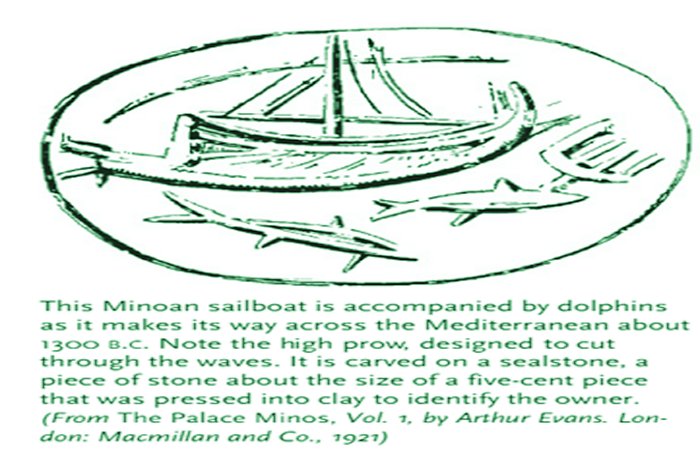 Minoan boat drawing/from "The Palace Minos"/A. Evans
Minoan boat drawing/from "The Palace Minos"/A. Evans
According to Yaacov Shavit, in his book "History in Black: African-Americans in Search of an Ancient Past," "there is a good deal of evidence regarding Cretan trade with Egyptian cities, particularly in the delta.."
However, much about them remains unknown. First, we know nothing about Minoan history, their enemies, rulers, prominent figures, and their attitude towards their neighbors.
Around 2000-1750 BC, the Minoans began to build palace complexes and ports.
The first large palaces were built at Knossos, Phaistos, and Malia. The Knossos Palace was once great, reaching not 1,400 but even 1,500 rooms within three or four stories and covering an area of about 20,000 square meters. The Phaistos and Malia palaces were smaller and covered about 10,000 and 7,500 sq. m., respectively. The palaces (for storage, recordkeeping, and habitation) were necessary as they controlled the foreign trade.
Greatness usually comes to an end. Something big happened toward the end of the period from 2100 BC to 1600 BC. It resulted in massive and widespread destruction of Crete. Palaces across the island were destroyed, including Phaistos, Knossos, Malia, and Kato Zakros. It is believed that a massive earthquake caused the Cretan problems. Around 1600 BC, the Minoans suffered another devastating catastrophe, this time the eruption of the volcano in Thera.
The Minoans reconstructed many of their palaces, but these buildings did not focus on their beauty anymore; they became much more practical.
“At the same time as the Minoans began to build the palaces, they also started to use the free-moving potter’s wheel, one of the most imported technical advances in their history: we do not know how the idea arose. The pottery wheel enabled them to produce lighter vases in greater numbers.” 1
The mysterious Minoan past has been largely excavated but is still not entirely explained. Many essential pieces of the Minoan puzzle are missing. Despite their impressive legacy, the origin of the Cretan population has yet to be discovered.
We know the Mycenaeans invaded the Minoans of Crete in about 1,400 BC.
Written by – A. Sutherland AncientPages.com Staff Writer
Copyright © AncientPages.com All rights reserved. This material may not be published, broadcast, rewritten or redistributed in whole or part without the express written permission of AncientPages.com
Expand for referencesReferences:
Phillips, Martin R. Ancient Civilizations: Discover the Ancient Secrets of Greece, Egypt, and Rome
History, Captivating. Minoans:
Cadogan Gerald, Palaces of Minoan Crete
Shavit, History in Black: African-Americans in Search of an Ancient Past
More From Ancient Pages
-
 On This Day In History: Famous American Author Edgar Allan Poe Found Dying – On Oct 3, 1849
News | Oct 3, 2016
On This Day In History: Famous American Author Edgar Allan Poe Found Dying – On Oct 3, 1849
News | Oct 3, 2016 -
 Mystery Of The Artificial Cave And Ancient Encounters With Short People With Strange Feet
Ancient Mysteries | Mar 20, 2025
Mystery Of The Artificial Cave And Ancient Encounters With Short People With Strange Feet
Ancient Mysteries | Mar 20, 2025 -
 Explorer Discovered A Lost Underground World Beneath Big Sur In North America – But Why Cannot Anyone Else Find It Now?
Ancient Mysteries | Feb 12, 2019
Explorer Discovered A Lost Underground World Beneath Big Sur In North America – But Why Cannot Anyone Else Find It Now?
Ancient Mysteries | Feb 12, 2019 -
 Ancient Nanotechnology Knowledge Inspired A Modern 3D-Printable ‘Lycurgus Cup’
Ancient Technology | Mar 13, 2019
Ancient Nanotechnology Knowledge Inspired A Modern 3D-Printable ‘Lycurgus Cup’
Ancient Technology | Mar 13, 2019 -
 On This Day In History: Magellan’s Expedition Circumnavigates Globe – On Sep 6, 1522
News | Sep 6, 2016
On This Day In History: Magellan’s Expedition Circumnavigates Globe – On Sep 6, 1522
News | Sep 6, 2016 -
 God Loki – Trickster, Elusive And Fascinating Member Of The Norse Pantheon
Featured Stories | Sep 14, 2017
God Loki – Trickster, Elusive And Fascinating Member Of The Norse Pantheon
Featured Stories | Sep 14, 2017 -
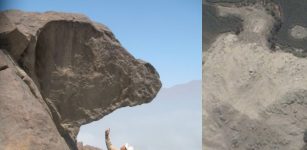 Rare Animal-Shaped Mounds Discovered In Peru
Archaeology | Apr 2, 2012
Rare Animal-Shaped Mounds Discovered In Peru
Archaeology | Apr 2, 2012 -
 Disbelief In Human Evolution Is Linked To Prejudice And Racism – Scientists Say
Human Beginnings | Apr 5, 2022
Disbelief In Human Evolution Is Linked To Prejudice And Racism – Scientists Say
Human Beginnings | Apr 5, 2022 -
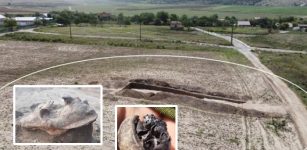 Archaeologists Make An Unusual Find In A 2,000-Year-Old Romanian Burial Mound
Archaeology | Jul 12, 2023
Archaeologists Make An Unusual Find In A 2,000-Year-Old Romanian Burial Mound
Archaeology | Jul 12, 2023 -
 The Colored Skeletons Of 9000-Year-Old Çatalhöyük (Catalhoyuk), Turkey – New Examination
Archaeology | Mar 18, 2022
The Colored Skeletons Of 9000-Year-Old Çatalhöyük (Catalhoyuk), Turkey – New Examination
Archaeology | Mar 18, 2022 -
 Ancient DNA Reveals How People Migrated During The Roman Empire
DNA | Feb 1, 2024
Ancient DNA Reveals How People Migrated During The Roman Empire
DNA | Feb 1, 2024 -
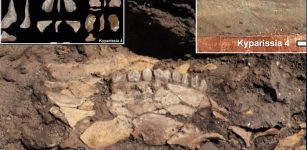 Greek Discovery Of Stone Tools In Megalopolis Area Pushes Back Greece’s Archaeological Record Up To 250,000 Years
Archaeology | Jun 2, 2023
Greek Discovery Of Stone Tools In Megalopolis Area Pushes Back Greece’s Archaeological Record Up To 250,000 Years
Archaeology | Jun 2, 2023 -
 Seafaring Hunter-Gatherers Reached Malta And Other Remote Islands Thousands Of Years Before The First Farmers
Archaeology | Apr 10, 2025
Seafaring Hunter-Gatherers Reached Malta And Other Remote Islands Thousands Of Years Before The First Farmers
Archaeology | Apr 10, 2025 -
 Huge Ptolemaic/Roman Funerary Structure Unearthed In Egypt’s Fayoum
Archaeology | Dec 6, 2022
Huge Ptolemaic/Roman Funerary Structure Unearthed In Egypt’s Fayoum
Archaeology | Dec 6, 2022 -
 Unique discovery of unknown inscription may change the history of scripts as we know it.
News | Aug 23, 2015
Unique discovery of unknown inscription may change the history of scripts as we know it.
News | Aug 23, 2015 -
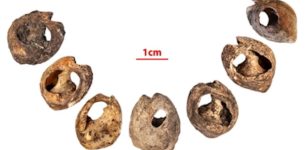 142,000-Year-Old Shell Beads Found In A Cave Are The Oldest Known Evidence Of Human Communication
Archaeology | Oct 16, 2021
142,000-Year-Old Shell Beads Found In A Cave Are The Oldest Known Evidence Of Human Communication
Archaeology | Oct 16, 2021 -
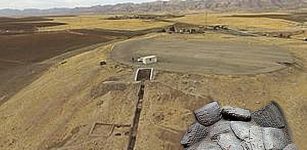 Bassetki Cuneiform Tablets Reveal Location Of Lost City Of Mardaman In Northern Mesopotamia
Archaeology | May 14, 2018
Bassetki Cuneiform Tablets Reveal Location Of Lost City Of Mardaman In Northern Mesopotamia
Archaeology | May 14, 2018 -
 Who Deceived Mighty Yuku God Of Rain And Thunder In Beliefs Of Yaquis Of Southern Arizona And Sonora, Mexico?
Native American Mythology | Dec 21, 2023
Who Deceived Mighty Yuku God Of Rain And Thunder In Beliefs Of Yaquis Of Southern Arizona And Sonora, Mexico?
Native American Mythology | Dec 21, 2023 -
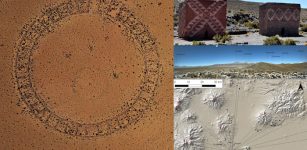 Mysterious Ancient Andean Waskiri Structure Built For Unknown Purpose Investigated By Scientists
Archaeology | Apr 14, 2023
Mysterious Ancient Andean Waskiri Structure Built For Unknown Purpose Investigated By Scientists
Archaeology | Apr 14, 2023 -
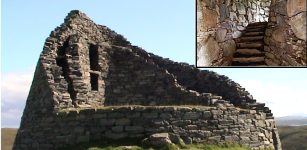 Brochs: Ingeniously Engineered Windowless Iron Age Structures Of Atlantic Scotland
Featured Stories | Sep 20, 2023
Brochs: Ingeniously Engineered Windowless Iron Age Structures Of Atlantic Scotland
Featured Stories | Sep 20, 2023

